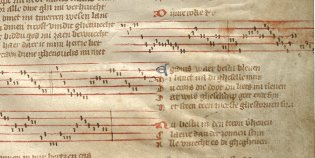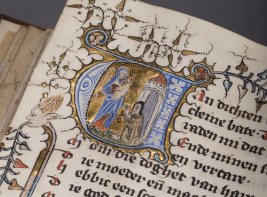Gruuthuse manuscript
The Gruuthuse Manuscript contains a collection of 147 songs, 7 prayers and 16 Middle Dutch poems written around 1400. The manuscript originated in Bruges. Around 1400, Bruges was a rich metropolis bustling with trade, music, art and culture. Therefore, we encounter many themes in the texts that deal with life in the city in the late Middle Ages: religion and love, for example, but also subjects such as drunkenness and sex.
The book in which this was written down is well preserved, complete with notes for the music. However, it was rebound in the 19th century, with the pages cut off on three sides. We know most of the texts from no other source. This makes this manuscript a great source of inspiration for researchers into early Dutch literature.
Well-known songs, poems and prayers from the collection
The Egidius song
In the best-known song from the collection, the main character is sad about his friend Egidius, who has passed away:
Egidius, waer bestu bleven?
Mi lanct na di, gheselle mijn.
Du coors die doot, du liets mi tleven.
Dat was gheselscap goet ende fijn,
Het sceen ten moeste ghestorven zijn
(…)
Nu bidt vor mi, ic moet noch sneven
Ende in de weerelt liden pijn.
Verware mijn stede di beneven:
Ic moet noch zinghen een liedekijn,
Nochtan moet emmer ghestorven sijn. (II, 98)
It translates roughly to:
Egidius, where have you gone? / I long for you, my friend / You died, you left me alive / It was once so good between you and me / but you had to die. / Now pray for me. I must live in sin / and suffer pain in the world. / Save a place for me next to you. / I still have to sing a song, / but one day I have to die.
Egidius is no longer there. He just died. And his friend must live. He is sad about that. The realization that Egidius is saving a place for him next to him gives the poet comfort.
The love song 'Calle'
Many Gruuthuse songs and poems are about love. Sometimes they are about desperate lovers and their unattainable loved ones. And sometimes the songs seem to describe real encounters between lovers. For example, in the following song in which the first letters of the lines together form the name 'Calle', then a form of Katelijne:
C om haer te mi, mijns hertzen vrouwe,
A n dir so staen de zinnen mijn.
L iever wijf ic niewer scouwe.
L aet dir genoughen mijn jonstlijc pijn
E nde doet mir dienen troost anschijn) (II,31
(Come quickly, my Heartbreaker, to me, / All my feelings are for you. / Dear, always the dearest, my secret / Love-is-suffering, never repent / And comfort me visibly, my Madam!)
Gruuthuse songs about sex
The Gruuthuse manuscript also makes fun of sex. In the song 'I have a scuerdeur open staen' (II, 86) the first character sees Brother Lollaert and Sister Lute making love in a barn:
Mettien slopic ter duren in
Al achter eenen corentas
Daer hoordic dat dat zusterkijn
Den cokerduunschen zouter las
Beede laghen zi int vlas
De cueule die daer vpperst was
Die docht mi drauen als een paert (II,86)
(Immediately I crept through the door / behind a sheaf of wheat. / There I heard that the little sister / was reading the 'Koverduins' psalm book. / They were both lying in the flax. / The brother who lay highest there / seemed to me to be trotting like a horse.)
The prayer 'Sonder smette saliche rose'
Daily life in medieval Bruges was mainly determined by the Catholic Church. Maria appears frequently in the Gruuthuse manuscript. She is compared to a rose and other flowers or to a fountain overflowing with grace. The most important Marian text in the manuscript is the adaptation of the Latin prayer 'Salve Regina', now called: 'Sonder smette saliche rose' (I,5). This prayer has 256 verses. The initial letters of the prayer together form the lyrics of the original song.
Browse the Gruuthuse manuscript online
You can browse this masterpiece online. Images of this book are available via Wikimedia Commons. You will find this masterpiece in the KB catalogue under request number KW 79 K 10.
Poets working with the Gruuthuse manuscript
During Museumnacht Den Haag 2022 the KB asked 6 poets to work with the Gruuthuse manuscript. They made their own interpretation of the of the multilingualism that plays such a major role in this manuscript. You can see the videos here.
Read more about the Gruuthuse manuscript
The following books about the Gruuthuse manuscript can be viewed in the reading room of the KB:
- Brinkman, Herman. Het Gruuthuse-handschrift: ingeleid en kritisch uitgegeven door Herman Brinkman, met een uitgave van de melodieen door Ike de Loos. Verloren, 2015.
- Koldeweij, Jos, Inge Geysen en Eva Tahon. Liefde en Devotie. Het Gruuthusehandschrift: kunst en cultuur omstreeks 1400. Ludion, 2013. Catalogus bij de tentoonstelling in het Gruuthusemuseum te Brugge.
- Brinkman, Herman, en Maria Van Daalen. Liefde, leven en devotie. Poëzie uit het Gruuthusehandschrift. Bekking Blitz Uitgevers, 2013. Op cd 6 liederen uit het handschrift uitgevoerd door het ensemble Fala Musica.









